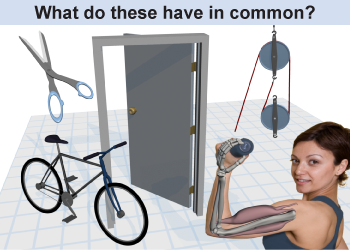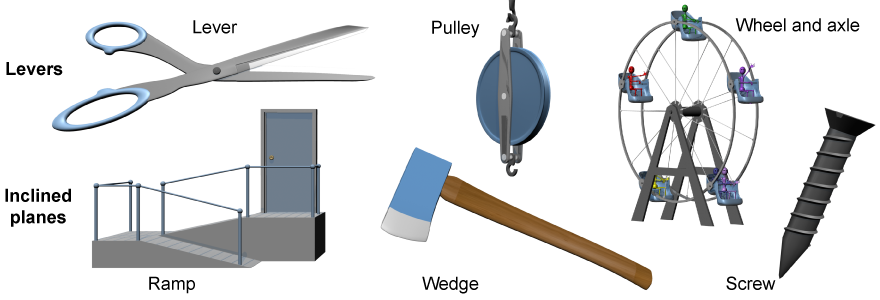|
 What do a bicycle, a pulley, a pair of scissors, a door hinge, and the human body have in common? You might not think of calling them all by the same name, but all are examples of machines. A machine is an assembly of moving parts through which forces act. A machine might change the direction of an applied force, change the magnitude of a force, or change both direction and magnitude. Pedals, gears, and levers are mechanical machines. Bones and muscles form biological machines. The same laws of physics apply to all machines, whether mechanical or biological.
What do a bicycle, a pulley, a pair of scissors, a door hinge, and the human body have in common? You might not think of calling them all by the same name, but all are examples of machines. A machine is an assembly of moving parts through which forces act. A machine might change the direction of an applied force, change the magnitude of a force, or change both direction and magnitude. Pedals, gears, and levers are mechanical machines. Bones and muscles form biological machines. The same laws of physics apply to all machines, whether mechanical or biological. 
|
Six types of simple machines
|
A simple machine is a mechanical system through which an applied input force directly creates an output force through a single motion. A simple machine has no source of energy except the instantaneous work done by the input force. The wheel of a bicycle is an example of a simple machine. The pedal and crank system on a bicycle is another example of a different simple machine. 
|
There are six types of simple machines: the lever, the pulley, the wheel and axle, the inclined plane, the wedge, and the screw. The physics of how they operate divides the six types into two groups: the levers and the inclined planes. You might not immediately see the relationship between a car engine and a simple lever. Nonetheless, the operation of any machine—no matter how complex—can be analyzed in terms of combinations of the six different simple machines. A car engine includes screws, ramps, levers, gears, and wheels. 
|
As a child you may have played on a lever called a “see-saw.” Levers are used to lift heavy objects, tighten lug nuts on a car’s wheel, or turn the gears on a bicycle. Levers work through torque and rotational motion. The pulley and the wheel and axle are two other simple machines related to the lever. 
|
It takes more force to lift a heavy load straight up compared to moving the same load up a ramp, even when the total height change is the same. A ramp is an example of an inclined plane, another simple machine. Inclined planes work by dividing forces acting along the direction of motion from forces acting perpendicular to the direction of motion. The wedge and screw are two other types of simple machines that are based on inclined planes. 
|

|
What category of simple machine is each of the following? - wrench
- broom
- nutcracker
- shovel
 |
All are examples of levers! 
|
| |
|

